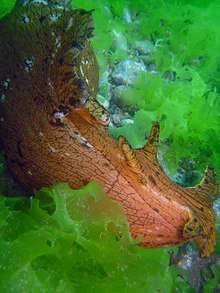Aplysia gigantea
Aplysia gigantea is a species of sea slug, a shell-less marine gastropod mollusk in the family Aplysiidae. The species was first described in the Journal of the Malacological Society of Australia in 1869.[1] A. gigantea is also known more commonly as the sea hare due to their posterior chemosensory tentacles resembling a hare's ear.[2] A. gigantea is the largest known species in Australia of the opisthobranch genus.[3] The species is known to have toxic effects on terrestrial organisms, particularly domestic dogs.[4] Exposure to this species with dogs has been associated with the development of neurotoxicosis, with symptoms ranging from respiratory distress to tremors, muscle fasciculations, and seizures.[4]
| Aplysia gigantea | |
|---|---|
 | |
| Scientific classification | |
| Kingdom: | Animalia |
| Phylum: | Mollusca |
| Class: | Gastropoda |
| Subclass: | Heterobranchia |
| Clade: | Euopisthobranchia |
| Clade: | Anaspidea |
| Superfamily: | Aplysioidea |
| Family: | Aplysiidae |
| Genus: | Aplysia |
| Species: | A. gigantea |
| Binomial name | |
| Aplysia gigantea Wells, 1986 | |
Distribution
Aplysia gigantea are commonly found near the southwestern corner of Western Australia, in soft sediment or reef environments.[2] They are found in shallow water, ranging from 0-20m in depth.[2] A. gigantea are most commonly witnessed from January to March, where beach strandings of this species can number in the hundreds.[3] A. gigantea are found most often in waters that range from 13.1-23.2 °C.[2] The species has not yet been assessed by the IUCN, and thus its conservation status remains unknown.[1]
Description
A. gigantea are known to be able to grow up to 60 cm long, making it one of the largest species of sea hare in Australia.[2] They are usually a dark brown or black color. Additionally, they are distinguished by large paradopia on their backs, which function as limbs allowing the sea hare to swim for short periods of time.[2] The species also has scent and taste receptors known as rhinophores, located on the upper side of its head.[4] These organs resemble a hare's ears and are responsible for its more colloquial name of sea hare. The sea hare's eyes are also located beneath the rhinosphores, and are able to sense light and shadow.[3] Its gills, as well as an internal, calcified shell are located near the organism's heart.[4] The shell itself is particularly fragile, and the paradopia serve a secondary function in both enclosing and protecting it.[4] The adults of this species are also herbivorous in nature, with a diet that primarily consists of algae.[1]
Defense
A. gigantea is able to produce ink and secretions from two main secretory glands that render it hidden or toxic to predators.[5] When ingested by domestic dogs, several symptoms have been recorded, including respiratory issues, ptyalism, emesis, ataxia, and hyperaesthesia.[4] It is suggested the diet of A. gigantea, consisting of organisms such as red algae, provides the molecules needed to create toxins.[2]
Reproduction
A. gigantea mate during summer and early autumn.[2] A. gigantea are hermaphrodites and often mate in numbers ranging from 2 to approximately 20, producing orange colored spawn.[2] In these mating groups, one individual will utilize only female or male reproductive organs respectively, while other participants use both.[2] The eggs produced by A. gigantea are in long and stringy clumps, and hatch into planktonic larvae which feed on microscopic algae.[3]
References
- Wells, Fred E. (January 1986). "A redescription of the sea hare Aplysia gigantea Sowerby, 1869". Journal of the Malacological Society of Australia. 7 (3–4): 173–178. doi:10.1080/00852988.1986.10673985. ISSN 0085-2988.
- jurisdiction=New South Wales; corporateName=Australian Museum; author=Rudman, W. B. (2006-01-09). "The Sea Slug Forum - Home". www.seaslugforum.net. Retrieved 2020-04-13.CS1 maint: multiple names: authors list (link)
- Bebbington, Alan (2010-07-08). "Aplysiid species from Eastern Australia with notes on the Pacific Ocean Aplysiomorpha (Gastropoda, Opisthobranchia)". The Transactions of the Zoological Society of London. 34 (1): 87–147. doi:10.1111/j.1096-3642.1977.tb00373.x. ISSN 0084-5620.
- Peacock, RE; Hosgood, G; Swindells, KL; Smart, L (2013-06-20). "Aplysia giganteatoxicosis in 72 dogs in Western Australia". Australian Veterinary Journal. 91 (7): 292–295. doi:10.1111/avj.12074. ISSN 0005-0423.
- Moroz, Leonid L. (January 2011). "Aplysia". Current Biology. 21 (2): R60–R61. doi:10.1016/j.cub.2010.11.028. ISSN 0960-9822. PMC 4024469.